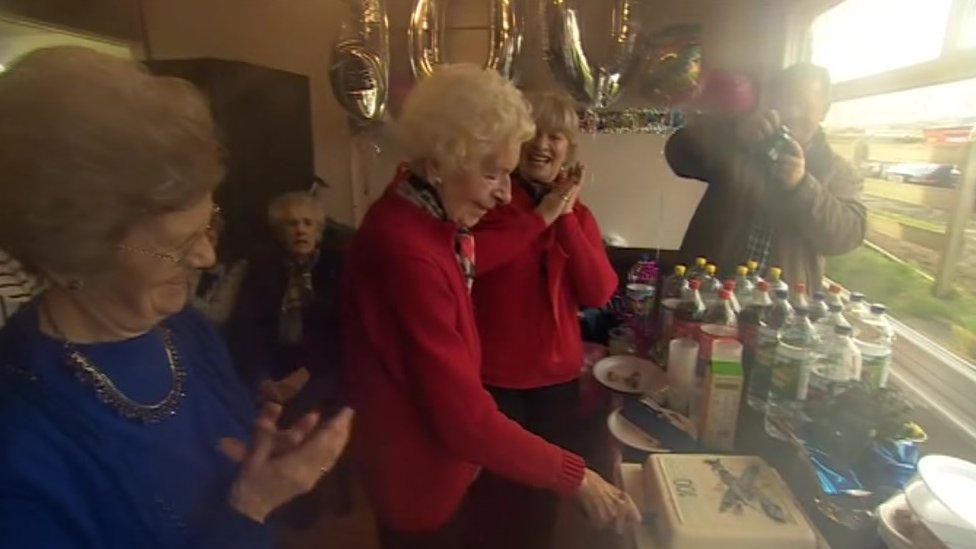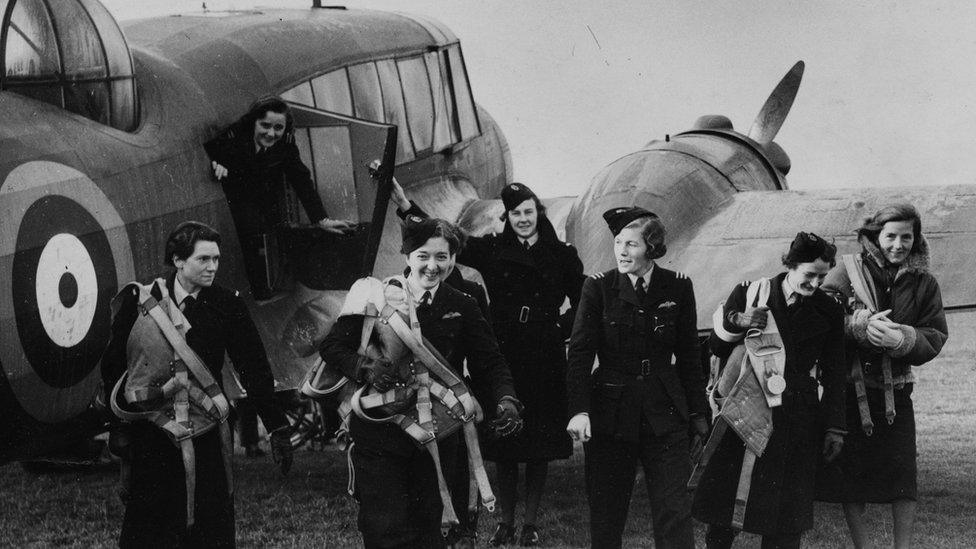WW2 Spitfire pilot Mary Ellis from Isle of Wight turns 100
- Published
Women were allowed to fly military trainer and communications aircraft from 1940
A woman who delivered Spitfires and bombers to the front line during World War Two has celebrated her 100th birthday.
Mary Ellis, one of the last surviving pilots of the Air Transport Auxiliary (ATA), was honoured at a surprise party at Sandown Airport, Isle of Wight.
About 60 guests gathered at the airfield, which she ran for 20 years.
The ATA ferried aircraft and pilots throughout the war until the service disbanded in November 1945.

Mary Ellis joined the ATA in 1941 after hearing an advertisement on BBC radio

Mary Ellis, one of the last surviving pilots of the Air Transport Auxiliary (ATA), was honoured at a surprise party at Sandown Airport, Isle of Wight.
Mrs Ellis said she had no idea everyone was planning to celebrate her centenary and had originally told everyone not to do anything because she "wasn't old enough" for a party.
Family and friends gathered to kick off the celebrations and although weather conditions stopped a Spitfire flypast, there was a cake with a picture of the aircraft on top.
Mary Ellis, then Mary Wilkins, joined the ATA in 1941 after hearing an advertisement for women pilots on BBC radio.
'Glamour Girls'
"At that time we were called the Glamour Girls and there were plenty of escorts around," she said.
Women were allowed to fly military trainer and communications aircraft from 1940, despite some male opposition.
The editor of Aeroplane magazine wrote in 1941: "The menace is the woman who thinks that she ought to be flying in a high-speed bomber when she really has not the intelligence to scrub the floor of a hospital properly."

Mrs Ellis said she flew about 1,000 aeroplanes during the war
Mrs Ellis recalled flying "about 1,000 aeroplanes" during the war, including some 400 Spitfires and 47 Wellington bombers, which she flew solo.
After the war she moved to the Isle of Wight and took charge of Sandown Airport from 1950 to 1970.
In November, she and fellow ATA pilot Joy Lofthouse were honoured in front of members of the Royal Family at the annual Festival of Remembrance at the Royal Albert Hall in London.
Mrs Ellis said the Spitfire has always been her favourite aircraft, she said: "I love it, it's everybody's favourite. I think it's a symbol of freedom."


Women in the ATA
The first eight women pilots joined the ATA in January 1940
They were among the first women in the UK to achieve equal pay, earning a fifth less than men until 1943
Initially restricted to non-operational aircraft, women flew fighters from July 1941 as aircraft production and casualties rose
In September 1942, Lettice Curtis became the first of 11 women to fly a four-engined bomber during WW2
168 women, including volunteers from the USA and other nations, served in the ATA during the war
About 15 female ATA members were killed during World War Two, including aviation pioneer Amy Johnson

- Published9 October 2015
